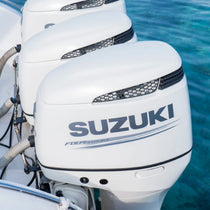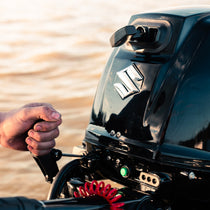How to winterize an outboard motor:
To winterize a 4-stroke outboard motor, flush the engine, stabilize the fuel system, apply fogging oil, change the lower unit oil, and disconnect the battery. These steps help prevent corrosion, fuel degradation, and engine damage during off-season storage.
Winterizing your Suzuki outboard motor ensures a smoother startup next season and protects against costly repairs. The good news? Most boaters can perform this DIY maintenance themselves and save time and money—no mechanic needed.
Learn how to winterize a 4-stroke outboard boat motor step-by-step, including flushing, fogging, and oil changes. Whether you're winterizing a 2-cycle outboard motor or a modern four-stroke, these tips help protect your engine and extend its life. Here’s what we’ll be covering about winterizing your Suzuki outboard:
- Completely Flush Your Engine
- Stabilizing Your Fuel System
- Fogging Your Suzuki Engine
- Change Your Lower Unit Oil
- Disconnect Your Battery
Frequently Asked Questions About Winterizing a Boat Motor
Do you need to winterize an outboard motor?
Yes, winterizing a boat motor is essential to protect it from corrosion, freezing, and ethanol-related fuel damage during storage. Neglecting winterization can lead to major repairs next season.
How do you winterize an outboard motor on a boat?
To winterize an outboard motor, flush the engine, add fuel stabilizer, fog the engine with fogging oil, change the lower unit oil, and disconnect the battery. These steps apply to most 4-stroke and 2-cycle outboards.
How to fog a 4-stroke outboard motor?
With the engine running, spray fogging oil into the air intake until it stalls. Then remove the spark plugs and spray fogging oil into each cylinder. Replace the plugs afterward.
Does an outboard motor need to be winterized every year?
If you store your boat in freezing conditions or for longer than 60 days, then yes. Annual winterization helps prevent long-term engine damage.
Can you winterize a 4-stroke outboard motor without running it?
While not ideal, some steps can be done without running the engine, like changing the oil and draining fuel. However, for full protection, running the engine with stabilized fuel and fogging oil is highly recommended.
Completely Flush Your Engine
Suzuki parts and tools you’ll need:
- Motor flusher
- Garden hose
- Water supply
Why it’s necessary: According to Suzuki Marine’s winterization guidelines and marine mechanics, flushing after every saltwater use and before off-season storage is considered best practice for engine longevity.
If you fail to remove this debris before winterization, it can wreak havoc on your engine. As the metal becomes oxidized by air’s moisture, this debris penetrates further and further into the engine. Over a matter of weeks, a loss of metal causes pitting, leaks, and affects the precision tolerances for your Suzuki motor. If your Suzuki sits with this type of corrosion for months, expect a significant engine overhaul to use your motor next season.

How to Flush Your Suzuki Outboard
When winterizing a 4-stroke outboard motor, you can flush the engine either while it’s off or running. Both methods help protect the motor from internal corrosion during storage:
Flushing Your Outboard with the Engine Off
- The first step to flushing your outboard with the engine off is to screw a garden hose into the motor flushing port, turn on the water, and let the water run for approximately 5 minutes. Pay attention to the flow of water and any sediment or blockages that exist. If the Suzuki outboard has been left unused for a while, you may even notice expelled pests that nested in the port.
- After flushing, remove the cowling cover from the Suzuki outboard and look for any grime or salt deposits that may have settled outside any engine components. If you spot any build-up, simply rinse it away. If you believe that you have pinhole leaks that let water into the engine, use a wet sponge or rag to wipe these deposits away. Look for any corrosion, as well, as this is a sign that water has leaked into the engine.
- Last, trim the engine to the up position to let as much water drain as possible. Once the water stops dripping, trim the engine back down to let it drip dry.
Flushing Your Outboard with the Engine Running
- To flush your Suzuki outboard with the engine running, you will start by attaching a motor flusher— earmuff or other design. Screw your garden hose onto the motor flusher, then slide the motor flusher over the outboard’s water intake. Be sure that the motor flusher is completely covering the water intake. Make sure you have a sufficient water supply, and that water is coming from both sides of the motor flushers.
- Next, turn on the engine. Make sure that water is flowing from the tell-tale hole and that the temperature of the water is relatively cool. If the water is too hot for you to hold your hand underneath the tell-tale, immediately turn off your engine. If the water is excessively hot, water is not flowing correctly, and you are overheating your engine—turn off the engine, reposition the earmuffs, and start again.
- After flushing the engine, remove the cowling cover from the Suzuki outboard and look for any grime or salt deposits that may have settled outside any engine components. If you spot any build-up, simply rinse it away. If you believe that you have pinhole leaks that let water into the engine, use a wet sponge or rag to wipe these deposits away. Look for any corrosion, which is a tell-tale sign that water has leaked into the engine.
- Last, trim the engine to the up position to let as much water drain as possible. Once the water stops dripping, trim the engine back down.
Stabilizing Your Fuel System
Parts and tools you’ll need:
- Fuel stabilizer (choose a brand suitable for long-term storage)
- Motor flusher
- Garden hose
- Water supply
Why it’s necessary: Gasoline with ethanol eventually goes bad when it sits in your Suzuki outboard’s fuel system during long-term storage. Due to the nature of ethanol-enriched gasoline, a process known as “phase separation” can occur within weeks, where ethanol binds to water molecules and sinks to the bottom of the tank.
This water-ethanol mixture is highly-corrosive and promotes damage along the entire internal fuel system of your Suzuki outboard.

How to Stabilize Your Fuel System
- To start, you’ll want to run your engine until it’s almost empty. Alternately, you can siphon the remaining fuel out of the engine and replace it during the next step, but it’s usually best to use only fresh gasoline.
- Add the appropriate amount of fuel stabilizer as directed on the product packaging to your fuel tank capacity (known as the “treat rate”).
- Next, fill your fuel tank with fresh gasoline to almost full, leaving a small space for expansion during storage. Choose gas with the lowest ethanol content possible, as the fuel will last longer. However, most importantly, continue to use the type of fuel you have been using. Modern outboard engines are designed to run gasoline with ethanol but do not go back and forth, sometimes using gasoline with ethanol and other times not.
- Hook up motor flushers/ear muffs to the engine, turn on the water source, and run the engine with the stabilized fuel for approximately 10 – 15 minutes. This ensures thorough circulation of the stabilized fuel throughout your fuel system.
Fogging Your Suzuki Engine
Parts and tools you’ll need:
- Fogging oil
- Crescent wrench
- Replacement spark plugs
- Motor flusher
- Garden hose
- Water supply
Why it’s necessary: Similar to flushing your engine to prevent corrosion, using fogging oil helps coat the internal components of your engine, protecting them against corrosion. This wax-based oil creates a substantial amount of white smoke as it works through your engine, leaving a protective coating on vulnerable internal engine components of your outboard.
How to Fog Your Suzuki Outboard
- Find a suitable outdoor area with proper ventilation.
- If applicable, remove your Suzuki outboard’s air cleaner to get to the carburetors or cylinder air intakes.
- Hook up the earmuffs and water supply as indicated in the previous winterizing procedures.
- Start your engine and rev the engine slightly above idle. With the engine running, spray the fogging oil into the carburetor(s) or air intake of each cylinder.
- Continuously spray the fogging oil into your outboard’s carburetors or cylinder air intake until the engine stalls. Make sure to spray a coating of fogging oil into each cylinder or carburetor for even coverage. However, don’t spray too much fogging oil at once and kill the engine immediately. Instead, use a gradual amount until the engine stalls. The stalling indicates that the engine is thoroughly covered with fogging oil.
- With the engine off, use a crescent wrench to remove all of the spark plugs and spray the fogging oil into each cylinder. Manually turn the flywheel to move the cylinders allowing you to coat the entire cylinder wall.
- Replace all of the old spark plugs with new spark plugs.
Change Your Lower Unit Oil
Parts and tools you’ll need:
- Lower unit oil / gear lube oil (for Suzuki outboards)
- Gear lube/oil pump
- Two new drain screw gaskets
- Drain pan
- Large flat head screwdriver
- A few rags

Why it’s necessary: Leaving old gear lube in your Suzuki Outboard is not recommended by most marine mechanics. The reason for this is that oil collects contaminants during regular usage, becoming corrosive and leaving sticky residues when it is stored for a period of time. Also, any water in the lower unit oil will likely expand as it freezes, potentially cracking your lower unit.
How to Change Your Suzuki Outboard’s Lower Unit Oil
- Begin by finding out how much lower unit oil/gear lube you will need to have on hand for a complete oil change. To do so, check your owner’s manual or find your engine model within our Suzuki Specs & Capacities Chart.
- Locate the lower and upper lower unit oil drain holes. With your drain pan in position, remove the lower drain screw first. The oil will start to drip out slowly into the drain pan.
- Next, remove the upper drain screw. This will cause the lower unit oil to drain out quickly. Allow the oil to drain completely.
- Pay attention to the condition of the lower unit oil.
- If the oil has a milky color, this indicates that there’s water in the lower unit, and you may need to troubleshoot the source of leakage before safely storing it for the winter.
- In that case, search “suzuki outboard parts dealer near me” online to find a qualified marine mechanic to diagnose the problem and fix the issue before it causes more damage.
- If the oil smells burnt, your engine is overheating, and you won’t need to troubleshoot why your engine is operating at temperatures outside of its specifications.
- With the oil completely drained, screw in your oil pump fitting and attach the pump to the bottom lower unit drain hole. Remove the cap of your bottle of lower unit oil and screw the pump onto the bottle. Pump until oil begins flowing out of the upper drain hole.
- Install a new lower unit drain gasket onto your upper screw plug. Insert the upper screw plug, hand tighten, then tighten securely with your flathead screwdriver.
- Install a new lower unit drain gasket on your lower screw. With the lower screw in your hand, remove the gear oil pump fitting. Quickly insert and tighten the lower screw. When done correctly, only a small amount of oil will spill out before securing the lower drain screw.
- Wipe everything down with rags and properly dispose of your old oil lower unit oil at a recycling facility.
Disconnect Your Battery
Parts and tools you’ll need:
- Battery terminal cleaner and protector
- Battery caps
- Wire brush
- Ratchet set
- Vaseline or WD40
Why it’s necessary: It’s important to disconnect your battery during storage, as the battery will drain if it remains connected and affects the longevity of reliable use. A battery that remains connected will often corrode on the terminals and may even rupture, spilling corrosive sulphuric acid around the battery compartment and cables. Also, if you leave your battery connected, your boat’s electronics will pull small amounts of power from the battery, and your battery will most likely be dead by spring.
How to Disconnect the Battery
- Remove the negative terminal of the battery with a matching ratchet set, then remove the positive terminal in the same fashion.
- Disconnect the battery cables.
- Spray the battery terminals with terminal cleaner and gently scrape away any corrosion on the battery terminals with a wire brush.
- Coat the battery terminals with vaseline or WD40 to protect against corrosion. Then secure the battery caps.
- Store your battery in a dry place until next season.

Quick Summary: How to Winterize a 4-Stroke Outboard Motor
- Flush the outboard engine thoroughly (with or without the engine running).
- Add fuel stabilizer and run the motor for 10–15 minutes.
- Fog the engine to prevent corrosion during storage.
- Change the lower unit oil and inspect for leaks or burnt smell.
- Disconnect and clean the battery terminals for long-term storage.
- Always refer to your owner’s manual or a certified mechanic if unsure.
Winterize Your 4-Stroke Suzuki Outboard Motor with PartsVu
Now that you know how to winterize a 4-stroke Suzuki outboard motor, you should know that proper Suzuki winterization requires Suzuki outboard parts and products– and PartsVu is happy to help you keep your outboard running for years of enjoyment!
Search our catalog for everything you need to run your Suzuki outboard motor reliably, and read PartsVu’s helpful article archives for everything you need to know about your Suzuki outboard motors.




















1 comment
“If the oil smells burnt, your engine is overheating, and you won’t need to troubleshoot why your engine is operating at temperatures outside of its specifications.” This should read “WILL need to troubleshoot…” Found a surprising number of typos reading various articles today. Look me up if you need proofreading work done.